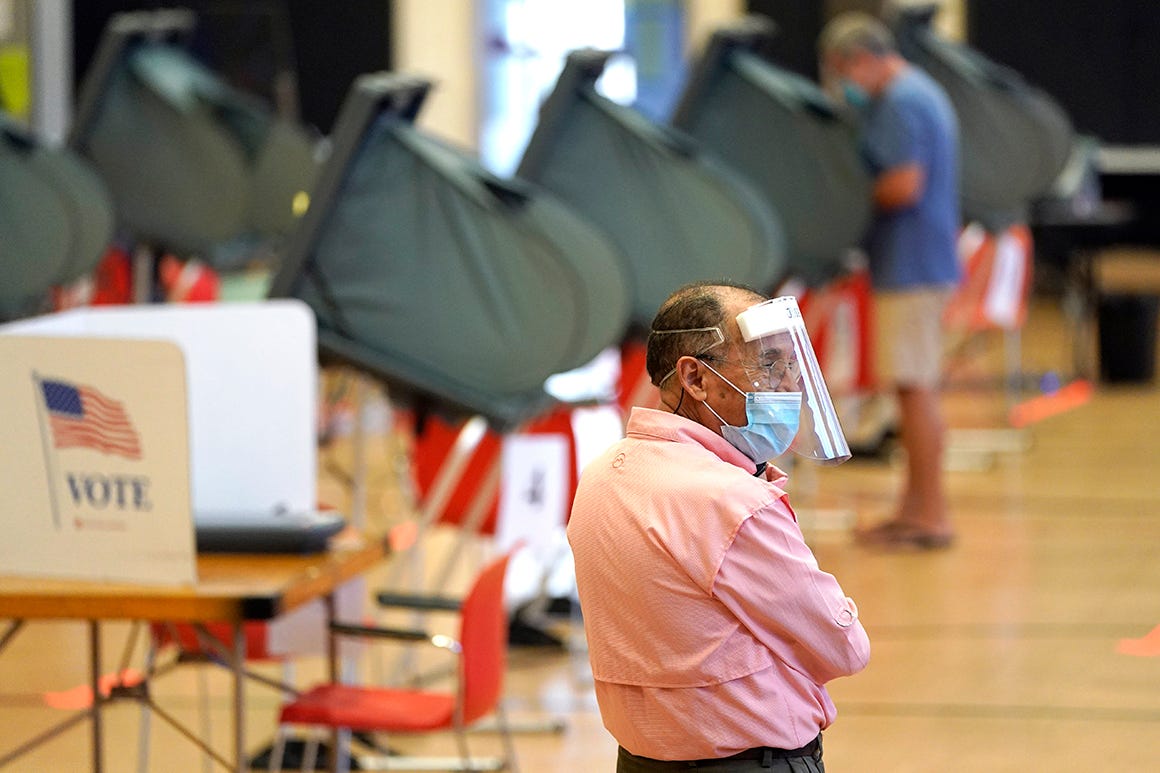
John Raoux/AP
- A majority of Americans plan to vote in person during the November election.
- The risk of contracting the coronavirus while voting in person is about the same as when ordering takeout, according to one epidemiologist.
- You can lower your risk further by taking precautions like bringing sanitizing equipment and voting when lines are shorter.
- Visit Business Insider’s homepage for more stories.
During Wisconsin’s primary election in early April, local officials, public-health experts, and poll workers all worried that in-person voting could spark a spike in coronavirus cases. About 1.55 million Wisconsinites voted in that election, 400,000 of whom voted in person.
But by mid-April, no spike had come, according to a CDC report published in July. That’s likely because polling places instituted safety precautions like mask requirements and social distancing. Photos and local news reports showed most voters wearing masks and standing at least 6 feet apart in line.
For people who plan to vote in person on November 3, the risk of contracting coronavirus will be similarly low, according to Saskia Popescu, an epidemiologist at the University of Arizona.
“I actually equate it with takeout,” Popescu, a leading expert on coronavirus transmission, told Business Insider. “There are so many safety protocols being put into place for safe voting that it is really a lower-risk activity.”
That’s because most polling places make people wear masks and line up outside, where it’s harder for the virus to spread from person to person. The process of voting in a booth takes just a few minutes, and most polling stations plan to sanitize all equipment indoors regularly.
Still, Popescu offered several tips for lowering your risk when voting in person, including bringing hand sanitizer and going when your polling place is less crowded.

Sara Stathas for the Washington Post
Voting is not too risky
At least 75% of American voters will be eligible to mail in their ballots this election, but only 39% currently plan to do so, according to the Pew Research Center. About 54% said they will vote in person, either early or on November 3.
With proper precautions, those in-person voters shouldn't face much coronavirus risk, according to Popescu.
"Most polling stations are requiring masks, you're able to distance, and your time inside is very short," she said.
Any interaction with a poll worker will probably only last a minute or two — much like paying a cashier for a takeout meal — which makes viral transmission unlikely.
Polling places are taking extra precautions
Most county government websites list the safety precautions they're planning or are already taking to make in-person voting safe.
"You can definitely read up on what your city or municipality is doing," Popescu said.
For instance, in Dekalb County, Georgia, poll workers will wear masks and face shields, and voting equipment will be cleaned at least once an hour. The county is "strongly encouraging" voters to wear masks and socially distance while waiting in line. In Maricopa County, Arizona, meanwhile, all polling locations are expected to provide voters with gloves and masks, and to disinfect pens after each use.
Ideally, a polling place should mandate mask-wearing and social distancing, and offer hand sanitizer and masks, Popescu said.
Some polling stations are even giving people a way to vote from their cars, which "is an awesome option," Popescu added.
How to stay safe when voting in person

David J. Phillip/AP
Popescu said wearing a mask "is really the biggest thing" you can to to protect yourself, along with social distancing.
Although many counties say polling places will regularly clean equipment like voting machines and pens, it may feel unsafe to pick up a pen that someone else has recently used. So bringing your own gear, like hand sanitizer, a pen, and even protective eye coverings, could lower your risk of getting COVID-19. It may even be worth it simply for the peace of mind.
Another potential risk factor is long lines, since those can lead to more exposure to potentially infected people. In Atlanta, Georgia, for example, some people already reported waiting as many as 12 hours to cast their ballots on the first day of in-person voting.

Jessica McGowan/Getty Images
But many county websites, such as the site for Travis County, Texas, post information about wait times. So if you're worried about standing in line with a lot of people, you can look up which polling stations have low wait times and when traffic is lightest. Then plan your vote timing accordingly.
No matter their length, voting lines should be outdoors and appropriately distanced, with about 6 feet between each person.
If you may not feel safe at your polling place, have a backup plan
If you arrive at your chosen polling place and still feel unsafe, you can try a different one in your county. It might help to ask friends who are also voting about their experiences at nearby locations.
If you think there's a chance you won't find a place that makes you feel safe, you could instead still vote by mail. But in most states, you need to request a mail-in ballot by late October. So make your decision soon.
Mail-in voting is more difficult for residents of Indiana, Louisiana, Mississippi, Tennessee, and Texas, however. These states have some mail-in voting but require voters to cite a reason other than the coronavirus to take part in that system. Being sick, disabled, or 65 and older count as valid reasons.
